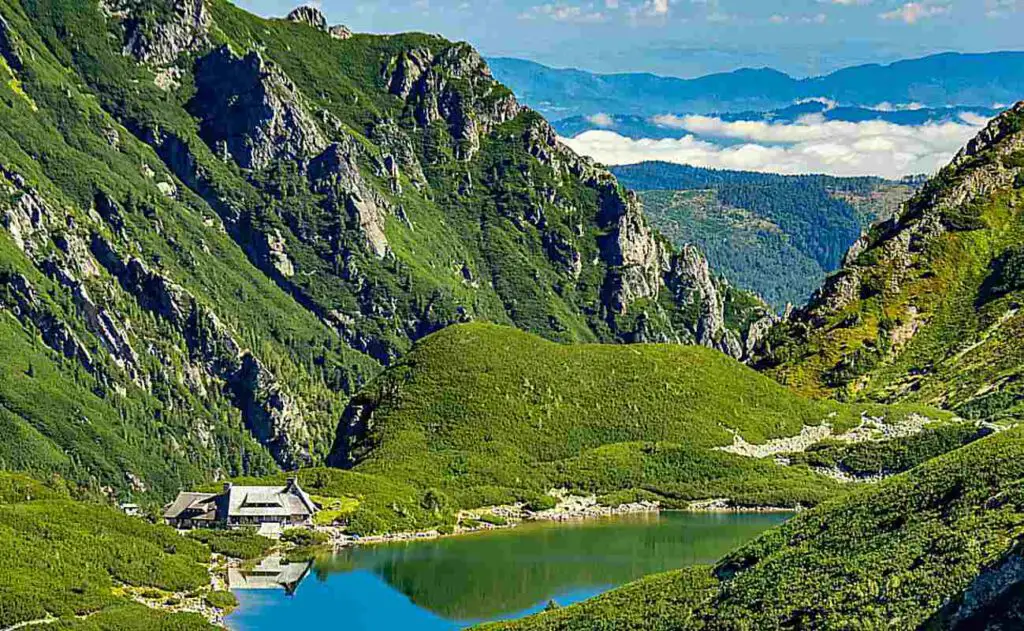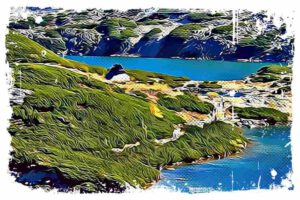Whether they’re big or small, offering an intimate atmosphere or a full-scale hotel experience, hosting iconic meetings and festivals, or known for their scrumptious apple pie, the hostels and shelters in the Polish Tatra Mountains are truly unique and captivating.

Let me say, if you’ve ever hiked in the Tatras, you’ve probably stumbled upon one of these places. Maybe you used their accommodation, stopped for a steaming cup of tea, or indulged in their famous apple pie. I can tell you that while some of these shelters may not have the same atmosphere as they once did, they remain incredible places that, aside from providing good food and a place to stay, offer a chance to experience a mountain adventure and meet interesting people.
„PTTK Morskie Oko” Shelter – A Lakeside Hostel in the Tatras
Nestled by the largest lake in the Tatras, the PTTK Morskie Oko shelter is one of the most visited hostels, and for good reason. Morskie Oko, regarded as the most beautiful of the Tatra ponds, offers breathtaking views no matter the time of year.
Read this article and learn more about Morski Oko legend: A Guide to Visiting Morskie Oko, The Emerald Lake Near Zakopane
↳ Before you head to Tatra Park, I highly recommend reading my complete guide to Tatra Mountains. I showcase the most scenic places you won't want to miss. Make sure to check it out, so you don't overlook anything interesting: Tatra Mountains – An Insider’s Guide to All Attractions and Info
From the shelter, you can marvel at the picturesque landscape of Morskie Oko, surrounded by forests and rock walls. The striking Mięguszowieckie Szczyty, the dark wall of Kazalnica, and the iconic silhouete of the Monk Peak all tower above the lake. If you need a perfect starting point for hikes into the higher parts of the Tatra Mountains, like Rysy, Przełęcz Pod Chłopkiem, and Szpiglasowa Przełęcz, this is it.
Two Buildings to Choose From
The PTTK Morskie Oko shelter actually consists of two buildings:
- „New Hostel”: Located right on the lake, it has 36 beds, a kitchen, and a luggage room.
- „Old Hostel”: Situated near the „New” building, it serves as a hostel with 43 beds available for tourists (the reception is in the New Shelter).
I believe it’s worth noting that the first shelter at Morskie Oko was built in 1874, but sadly it burned down in 1898. The next one opened in 1908, and during that time, the coach house (today’s „Old Shelter”) served as a shelter. The building underwent expansions and modernizations in the interwar period, and during World War II, it housed a unit of the German border guard.
The most convenient route to the shelter starts from Palenica Białczańska, and it’s about 8 km along an asphalt road. The Łapiński family has managed the shelter since the post-war years. Wanda and Czesław Łapiński ran it from 1945 to 1980, followed by their son Wojciech until 1985. After his untimely death, his wife Maria took over, and she now runs the shelter with her daughter Patrycja and son Jakub.

In 1997, Pope John Paul II visited this special place. The hostel is named after Stanisław Staszic, who explored the lake in 1805.
Historical Significance: The Oldest Shelter in the Polish Tatras
The „Old Shelter” – the coach house – is currently the oldest existing shelter in the Polish Tatras. Both buildings of the shelter have been declared historic. For more information, visit:
Possible Trips Starting From Morskie Oko – Where To Go?
Morskie Oko serves as a fantastic starting point for numerous trips in the area. Here are some great options for you to consider:
- Stroll around the pond: Take a leisurely walk along the wide stone path surrounding Morskie Oko. The direction doesn’t matter, and the round trip takes about an hour. Just follow the red signs.
- Visit Czarny Staw pod Rysami (Black Pond): One of the most beautiful Tatra ponds,
- Hike to Rysy: There are two options here: either return from the summit using the same route, or descend to the Slovak side.
- Explore Przełęcz Pod Chłopkiem: Known as one of the most beautiful and challenging routes due to its high exposure, start from Czarny Staw and follow the green trail.
- Trip to the Valley of Five Polish Ponds: Travel through Szpiglasowa Przełęcz and descend to the Roztoki Valley. The reverse route is also an option: Szpiglasowa Przełęcz from Valley to Morskie Oko.
- Discover Wrota Chałubiński: Head to Dolinka, pass Mnich, and take the red trail towards the Wrota Chałubiński pass.
- Trip to the Valley of Five Polish Ponds: Go through Świstówka Roztocka and continue to the Roztoki Valley. Please note that this trail is closed from December 1 to May 15.
Shelter in the Valley of Five Polish Ponds – The Highest Situated Hostel in Poland

The PTTK Shelter in the Valley of Five Polish Ponds holds the title of the highest mountain shelter in Poland, sitting at an altitude of 1671 meters above sea level. This popular spot is located in one of the most beautiful places in the Polish Tatra Mountains, making it no surprise that it’s usually crowded.
I highly recommend visiting this valley and shelter during summer and autumn. During these seasons, you can enjoy the trail that leads to Siklawa, the largest Tatra waterfall (about 70 meters high). And after your hike, treat yourself to the delicious apple pie the shelter is famous for.
A Brief Overview of the PTTK Shelter in the Valley of Five Polish Ponds
Named after Leopold Świerz, a mountain climber and researcher of the Tatra Mountains, the PTTK Shelter is a year-round facility that is open regardless of weather conditions. It offers 67 beds, meals, equipment rental for winter tourism and cross-country skiing, free luggage storage for lighter mountain excursions, and a tourist kitchen for those with their own provisions. The 5+ Mountain School at the shelter organizes avalanche courses, mountaineering, and winter tourism courses.
The Krzeptowski family has been associated with the shelter for generations. Currently, housekeepers Marychna and Marta, granddaughters of the legendary Maria and Andrzej Krzeptowski, manage the place. For contact information and more details, visit
Great Starting Points for Hikes from the Hostel in the Valley of Five Polish Ponds
The shelter serves as an excellent base for various hikes, including:
- Szpiglasowy Wierch and onwards to Morskie Oko: Szpiglasowy Wierch from „Five Ponds” to Morskie Oko
- Morskie Oko via Świstówka (the trail is open from mid-May to the end of November)
- Hala Gąsienicowa via Przełęcz Zawrat
- Hala Gąsienicowa via Kozia Pass (through Pusta Dolinka)
- Hala Gąsienicowa through the Krzyżne Pass (from the Pańszczyca Valley, you can go to Rówień Waksmundzka and Rusinowa Polana)
- Kozi Wierch
- Individual sections of Orla Perć from the Zawrat Pass, through Kozia Przełęcz, Kozi Wierch, Granaty, Buczynowe Turnie, up to Krzyżne
- Through the Zawrat Pass to Świnica and onwards to Kasprowy Wierch
- Pusta Dolinka: Winter Valley of Five Ponds and Pusta Dolinka
You may also want to read this article: The Beauty of the Tatra Mountains – 20 Best Hiking Trails
Shelter in Hala Kondratowa – The Smallest Hostel in the Polish Tatras

Despite being the smallest shelter in the Polish Tatras with only 20 beds, the PTTK Shelter in Hala Kondratowa is well-known among tourists. It lies along one of the most popular trails to Giewont. Every year, thousands of visitors flock to this destination, many using it as a stop on their longer mountain walks from Kuźnice (following the blue trail through Kalatówki) – a trip that takes around 1 hour. The area is also a popular destination for ski touring trips.
Facilities and Features of the Shelter
The shelter offers 20 beds in 3 rooms for 6 and 8 people, a ski storage room, an inn, and a buffet. Known for its intimate atmosphere and delicious gingerbread, the shelter is named after Władysław Krygowski, a renowned expert on the Carpathians.
The current building was constructed between 1947 and 1948 by the Polish Tatra Society and expanded in 1950. Stanisław Skupień, a skier and Olympian, became its manager. After his death in 1983, his son Andrzej took over the management. Since 2003, the shelter’s manager is Iwona Haniaczyk, granddaughter of Stanisław Skupień and niece of Andrzej.
Near the shelter, you can find massive boulders weighing several dozen tons. These are the remains of a stone avalanche that descended from Długi Giewont range in 1953. One of the boulders fell onto the building and got stuck in the corner of the dining room, while two others stopped just a few meters from the shelter.
Hiking Options from the Hostel on Kondratowa Valley
From the shelter, you have several options for further exploration:
- Follow the blue trail to Kondracka Przełęcz and onward to Giewont – the hike from the shelter takes about 2:05 hours (check out our article on Giewont in winter) or head to the ridge of Czerwony Wierchy.
- Take the green trail to Przełęcz pod Kopą Kondracka – the hike takes around 1:20 hours, and the return to the shelter takes about 1 hour.
PTTK Shelter on Polana Chochołowska – The Largest Hostel in the Polish Tatra Mountains

Located in the largest Tatra valley, the PTTK Shelter on Polana Chochołowska (1146 m above sea level) is the biggest shelter in the Polish Tatras, offering 121 beds. Facilities include a common room, ski storage room, tourist kitchen, and clothes drying room. Additionally, there is a TOPR (rescue service) duty station nearby.
Exploring the Chochołowska Valley Year-Round
The shelter and the Chochołowska Valley are popular destinations for trips and walks throughout the year. In spring, tourists and photographers flock to the area to admire the carpets of crocuses, while winter attracts cross-country and downhill skiers. The shelter is an ideal accommodation and starting point for exploring the Western Tatras, including Trzydniowiański Wierch, Starorobociański Wierch, Ornak, Bystra, and Rohacze. The famous „Deser Chochołowski” is a culinary delight not to be missed.
History of the The Shelter on Polana Chochołowska
The present building was constructed in 1953 and offers 121 beds in 2, 3, 4, 6, 8, and 14-bed rooms. The shelter features a plaque commemorating the TOPR rescue operation from February 11-12, 1945, when wounded partisans from Skrajny Salatyn were transported to safety. Another plaque commemorates the 1938 attempt to launch the „Star of Poland” balloon from Polana Chochołowska.
In June 1983, Pope John Paul II met with Lech Wałęsa and his family at the shelter. Following the meeting, a commemorative plaque was placed on the building’s wall, and a papal trail was marked out in the Jarząbcza Valley. Inside the shelter, visitors can find a sculpture gifted to the Pope by Lech Wałęsa.
The shelter is managed by Irena Gąsienica-Roj and Maria Krzeptowska. While the current building is the largest shelter in the Polish Tatras, its predecessor, built in 1930-1932 by the Warsaw Ski Club, was even more impressive, with 200 beds, including 170 on beds. The Germans occupied the previous shelter in 1939, creating a border guard post among other things. The building was destroyed by artillery fire in 1945.
For more information and contact details, visit:
Great Starting Point for Western Tatras Exploration
The shelter serves as an excellent starting point for exploring the higher parts of the Western Tatras, including:
- Grześ and Rakoń
- Trzydniowiański Wierch and Starorobociański Wierch
- Ornak, Błyszcz, and Bystra
- Rohacz Ostry and Plazyczny
PTTK Mountain Shelter at Hala Ornak

The PTTK Mountain Shelter in Hala Ornak is situated in Mała Polanka Ornaczańska, in the upper part of the Kościeliska Valley in the Western Tatras at an altitude of 1100 m above sea level. Known for hosting iconic meetings and events, such as „Summer Evenings at Hala Ornak„, the shelter is named after Prof. Walery Goetel, a nature protection activist and president of the PTT and later the PTTK Mountain Tourism Committee.
A Popular Stop for Tourists
The shelter at Hala Ornak is a popular stop for tourists visiting the Kościeliska Valley, drawing large crowds during the summer season. The hostel has 49 beds, a dining room, buffet, and kitchen. Guests can enjoy views of Kominiarski Wierch, Błyszcz, and Bystra from the windows. The current building was constructed in 1948, based on a design by Anna Górska.
The Krzeptowski family has long been associated with the shelter. For several years, the host was Józef Krzeptowski, son of the legendary couple from the Shelter in Five Ponds, Maria and Andrzej Krzeptowski. Since 1996, the building has been leased by Grzegorz and Anna Gąsienica Daniel, Józef’s daughter.
For more information, visit the shelter’s website:
The first shelter in this Valley was built in 1909 in Polana Pyszna. It was very popular among skiers, and numerous skiing events were organized there in the 1930s. During World War II, the shelter served as a transfer point for Tatra couriers. It was burnt down in 1945 during fights betwen the Germans and partisans.
Exploring the Western Tatras from Hala Ornak
The shelter on Hala Ornak serves as an excellent base for trips to the higher parts of the Western Tatras, such as:
- Tomanowa Przełęcz (1686 m),
- Błyszcz (2159 m) and Bystra (2248 m),
- Starorobociański Wierch (2175 m),
- Ornak (1854 m),
- Czerwone Wierchy.
Shelter in Roztoka Valley – A Winner in Hospitality

The shelter in Roztoka (1031 m above sea level) is nestled below the outlet of the Roztoka Valley in the Białka Valley, along the old forest road to Morskie Oko. The location is renowned for its delicious homemade cuisine and warm atmosphere. For many years, it ranked among the best Polish PTTK mountain shelters in the „npm” polish magazine. The shelter offers 75 beds and features a canteen, buffet, common room, bathrooms, showers, a tourist kitchen, and a drying room.
Before going to Tatras, please read this: The Best Times of Year and Weather to Visit the Tatra Mountains
Hosts and History of the Hostel
Since November 2008, Anna and Stefan Krupa from Chochołów have been the hosts of the shelter. The first tourist hostel in this location was built in 1876, making it the second facility in the Polish Tatras, following the old shelter at Morskie Oko. In 1911, the original building was demolished, and a new shelter was constructed in its place during 1911-1912.
The facility was expanded several times in the interwar period. During World War II, it served as a transfer point for Poles traveling to Hungary and later as a post for the German border guard. After the war, the hostel resumed its original function.
The shelter has been a popular destination for mountaineers, artists, and poets, including Walery Eljasz-Radzikowski, Tytus Chałubiński, and Stanisław Witkiewicz.
Trip Starting From the Roztoka Hostel
From the shelter in Roztoka, visitors can venture to:
- The Valley of Five Ponds – 2.20 h,
- Morskie Oko – 1.45 h.
For more information and contact details, visit the shelter’s website:
Mountain Hostel PTTK Kalatówki – For Nature Lovers and Jazz Enthusiasts

The Mountain Hotel PTTK Kalatówki is situated on the picturesque Kalatówki glade at an altitude of 1,198 m above sea level. It lies along a popular trail from Kuźnice to Kondratowa Polana and onward to Giewont. The path leading to the hotel, known as „Brother Albert’s Road”, is a comfortable route paved with granite stones. Travelers can reach the hotel in just 40 minutes from Kuźnice. In spring,
Kalatówki is famous for its blooming crocuses, and during the summer, visitors can experience cultural sheep grazing and purchase traditional shepherd’s products such as oscypek cheese, bundz, and Żętyca at a nearby shepherd’s hut.
Amenities and Activities at the Hostel
The hotel offers 86 comfortable beds in well-appointed rooms and features a restaurant, cafes, gym, and sauna. A T-bar ski lift is available on the glade, along with a tourist equipment rental, ski school, and the Tatra National Park Avalanche Center. Since 1998, the Kalatówki Glade has hosted the „For the Easter Egg” competition on Easter Monday, a popular event where participants use old ski equipment.
Kalatówki is also known for its iconic „Jazz Camping” events, which began in 1959-1960 and resumed in 1997. These gatherings have attracted famous polish jazz musicians like Krzysztof Komeda, Jerzy „Duduś” Matuszkiewicz, Andrzej Kurylewicz, and Zbigniew Namysłowski.
The hotel has also played a role in the development of skiing in the region, with the first ski resort in the Polish Tatras and the first ski competition held here in 1910.
History of the Hostel
The current building was designed by Józef Jaworski and constructed in 1938 by the TTN, ahead of the FIS World Ski Championships in 1939. During the war, it served as a rest house for senior German officers and functionaries under the name „Berghaus Krakau”. The first, so-called „old shelter” in Kalatówki, was built in 1911-1912 by the Tatra Ski Society. During World War II, the building was used as a warehouse and was destroyed by fire in 1943.
For more information and contact details, visit the hotel’s website:
PTTK Hostel „Murowaniec” – A Historical Shelter Opened by the President

The „Murowaniec” shelter, nestled on Hala Gąsienicowe, was officially opened in 1925 by the President of the Republic of Poland, Stanisław Wojciechowski. It was also attended by General Mariusz Zaruski, the founder of TOPR, and Father Walenty Gadowski, the creator of Orla Perć. The building was designed by architect Zdzisław Kalinowski, while the construction was initiated by Stanisław Osiecki, president of the Warsaw Branch of the Polish Tatra Society and deputy marshal of the Sejm.
Construction work lasted nearly four years, with units of the Polish Army contributing to the efforts. Granite boulders from the walls of Kościelec were used during the construction of the shelter. An interesting feature of the shelter is the „surprise cross” – a swastika sign on the balustrade of the stairs, which was a popular decorative element in Podhale used for protection against evil.
Beautiful Surroundings and a Wide Range of Activities
Hala Gąsienicowa and the hostel are popular destinations in the Polish Tatra Mountains, renowned for their breathtaking panoramas of the Tatras. A great attraction for families with children or elderly visitors is the trip through the Między Kopami Pass to Hala Gąsienicowa, a visit to the shelter, and a walk to Czarny Staw Gąsienicowy. In summer, fields of blooming willowherb create a spectacular scene, while in late autumn, golden-red grass contrasts beautifully against the snow-covered peaks of the Tatra Mountains.
Comfortable Accommodation and Amenities
The hostel is situated at an altitude of 1,500 m above sea level and offers 110 beds in rooms for 2 to 6 people, as well as rooms for 10 people. Facilities include a buffet, restaurant, luggage room/ski room, tourist equipment repair point, and clothes drying area. A TOPR duty station is also located on the premises. Since 2019, Andrzej Szatkowski and Michał Postupalski (WYSOKA company) have been the hosts, carrying out extensive renovations to improve the facility.
Starting Point for Tatra Mountain Adventures
PTTK Hostel „Murowaniec” is one of the main starting points for excursions into the higher parts of the Polish Tatras. From here, you can embark on journeys to:
- Krzyżne,
- Granaty,
- Kozi Wierch, Kozia Przełęcz,
- Zawrat,
- Świnica,
- Kasprowy Wierch,
- Kościelec,
- Gęsia Szyja,
- Czarny Staw Gąsienicowy.
Additionally, you can hike further to the Five Ponds Valley or through Czerwone Wierchy into the Western Tatras. Visit the shelter’s website at
- https://murowaniec.com/schronisko/ for more information.
Betlejemka – The Central Training Center of Polish Alpinism Association
Just a few minutes from „Murowaniec” lies Betlejemka, a small wooden building that houses the Central Training Center of PZA. It serves as a training and year-round accommodation base for mountaineers. Course participants and guests have acces to a 20-person room, sanitary facilities with a shower, and an electric tourist kitchen, while instructors have an 8-person room on the ground floor. No catering services are available
References:
- https://pl.wikipedia.org/wiki/Schronisko_turystyczne



